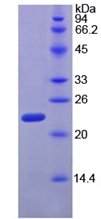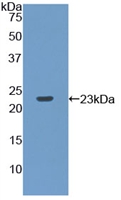Active Ribonuclease P (RNASEP)
Rnase-P; RNASEP1; RPP40; Ribonuclease P/MRP 40kDa Subunit
- Product No.APA198Ra01
- Organism SpeciesRattus norvegicus (Rat) Same name, Different species.
- Buffer FormulationPBS, pH7.4, containing 0.01% SKL, 5% Trehalose.
- Traits Freeze-dried powder
- Purity> 97%
- Isoelectric Point6.2
- ApplicationsCell culture; Activity Assays.
- DownloadInstruction Manual
- UOM 10µg50µg 200µg 1mg 5mg
- FOB
US$ 308
US$ 770
US$ 1540
US$ 4620
US$ 11550
For more details, please contact local distributors!
ACTIVITY TEST

Ribonuclease P is a site specific endonuclease that generates mature tRNAs by catalysing the removal of the 5'-leader sequence from pre-tRNA to produce the mature 5'-terminus. It can also cleave other RNA substrates such as 4.5S RNA. In bacteria, RNase P consists of of two components: a large RNA (about 400 base pairs) encoded by rnpB, and a small protein (119 to 133 amino acids) encoded by rnpA. The RNA moiety of RNase P carries the catalytic activity; the protein component plays an auxiliary, but essential, role in vivo by binding to the 5'-leader sequence and broadening the substrate specificity of the ribozyme. The sequence of rnpA is not highly conserved, however there is, in the central part of the protein, a conserved basic region. Besides, Nucleophosmin (NPM) has been identified as an interactor of RNASEP, thus a binding ELISA assay was conducted to detect the interaction of recombinant rat RNASEP and recombinant rat NPM. Briefly, RNASEP were diluted serially in PBS, with 0.01% BSA (pH 7.4). Duplicate samples of 100uL were then transferred to NPM-coated microtiter wells and incubated for 2h at 37℃. Wells were washed with PBST and incubated for 1h with anti-RNASEP pAb, then aspirated and washed 3 times. After incubation with HRP labelled secondary antibody, wells were aspirated and washed 3 times. With the addition of substrate solution, wells were incubated 15-25 minutes at 37℃. Finally, add 50µL stop solution to the wells and read at 450nm immediately. The binding activity of of RNASEP and NPM was shown in Figure 1, and this effect was in a dose dependent manner.
USAGE
Reconstitute in 10mM PBS (pH7.4) to a concentration of 0.1-1.0 mg/mL. Do not vortex.
STORAGE
Avoid repeated freeze/thaw cycles. Store at 2-8°C for one month. Aliquot and store at -80°C for 12 months.
STABILITY
The thermal stability is described by the loss rate. The loss rate was determined by accelerated thermal degradation test, that is, incubate the protein at 37°C for 48h, and no obvious degradation and precipitation were observed. The loss rate is less than 5% within the expiration date under appropriate storage condition.
GIVEAWAYS
INCREMENT SERVICES
-
 BCA Protein Quantification Kit
BCA Protein Quantification Kit
-
 Molecular Mass Marker for Protein
Molecular Mass Marker for Protein
-
 Monoclonal Antibody Customized Service
Monoclonal Antibody Customized Service
-
 Polyclonal Antibody Customized Service
Polyclonal Antibody Customized Service
-
 Protein Activity Test Experiment Service
Protein Activity Test Experiment Service
-
 Electrophoretic Mobility Shift Assay (EMSA) Experiment Service
Electrophoretic Mobility Shift Assay (EMSA) Experiment Service
-
 Buffer
Buffer
-
 Lentivirus Packaging Experiment Service
Lentivirus Packaging Experiment Service
-
 Adenovirus Packaging Experiment Service
Adenovirus Packaging Experiment Service
-
 Real Time PCR Experimental Service
Real Time PCR Experimental Service
-
 Spike RBD Protein (S-RBD)
Spike RBD Protein (S-RBD)
-
 Protein G
Protein G
-
 Protein A
Protein A
| Catalog No. | Related products for research use of Rattus norvegicus (Rat) Organism species | Applications (RESEARCH USE ONLY!) |
| RPA198Ra01 | Recombinant Ribonuclease P (RNASEP) | Positive Control; Immunogen; SDS-PAGE; WB. |
| APA198Ra01 | Active Ribonuclease P (RNASEP) | Cell culture; Activity Assays. |
| PAA198Ra01 | Polyclonal Antibody to Ribonuclease P (RNASEP) | WB; IHC; ICC; IP. |








